 Lucy Woodall, husband John and son Trevor
Lucy Woodall, husband John and son Trevor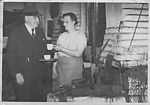 Lucy with the Boss at Stevens'
Lucy with the Boss at Stevens'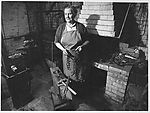 Lucy at her hearth at Woodhouse's
Lucy at her hearth at Woodhouse's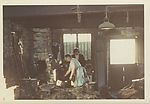 Lucy at the forge at Woodhouse's, photo by Ron Moss
Lucy at the forge at Woodhouse's, photo by Ron Moss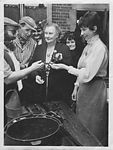 Lucy accepting the Vice Presidency of the Black Country Society, at the Pear Tree Inn, Mincing Lane, Rowley Regis
Lucy accepting the Vice Presidency of the Black Country Society, at the Pear Tree Inn, Mincing Lane, Rowley Regis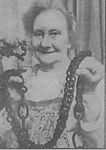 Lucy aged 79
Lucy aged 79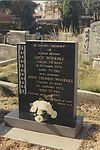 Lucy Woodall's Headstone
Lucy Woodall's Headstone

Lucy Woodall was a young girl at the time of the women chainmakers' strike in 1910. She remembered the women and their fight for a minimum wage. "I can still picture them in my mind," she said, "the women coming up Cradley. I was about ten and wasn't yet at work. There was uproar. It was when Macarthur came and they did carry on." (Rob Woolley, "Gi it sum 'ommer") By the time the Workers' Institute was built in 1912, using the funds left over from the strike, Lucy herself was getting ready to start her life as a chainmaker.
Unlike so many of the chainmakers, Lucy's story has not been lost. Her son Trevor has kindly loaned the Museum his collection of photographs and newspaper cuttings. Also Carl Chinn, in collaboration with the Express and Star, has included her story in his book, "Black Country Memoirs", from which much of our information is taken.
Lucy's Headmistress at Corngreaves School tried to persuade Lucy to go into dressmaking rather than the chain trade, because she was a talented needleworker. But Lucy said it was what she wanted, and the money was needed at home.
Lucy was thirteen when she started her apprenticeship at Horton's chain factory in Park Street, Old Hill. She worked for twelve hours a day, five days a week, and seven hours on Saturday, for 4 shillings (20p). Each week she handed over her wages to help support the family, keeping only 2d (less than 1p) for herself.
She finished her apprenticeship in 1915, and moved to Elizabeth Perry's chain shop. She made cavalry chain for the war effort. Later she moved to William Stevens', and in the early 1920s to Harry Stevens' in Oak Street, Old Hill. She worked there for 35 years. Mostly she made chain for agriculture.
Lucy carried on working when Harry Stevens' was taken over by Samuel Woodhouse, only retiring in 1969. Within two weeks she was bored, and went back to work, part-time .Only painful arthritis managed to stop her making chain, in 1973.
Lucy's life had been hard, with a fair share of tragedy. Her husband died of pneumonia when he was only 35. But she was a remarkable woman. As Dr. Carl Chinn said , "They were women of whom we should be proud and whose names should be recorded so that those yet to come shall understand them, appreciate them, and never forget them." (Express and Star, March 25th 2004)
Rollover the captions in the box to see the available images in thumbnail format, click the caption to see the full-size image
| Reference: | 679 |
| Keywords: | |
| Archive Ref: | |
| Updated: | Thu 12 Jul 2007 - 1 |
| Interpretation written by | Barbara Harris |
| Author's organisation | |
| Organisation's website |